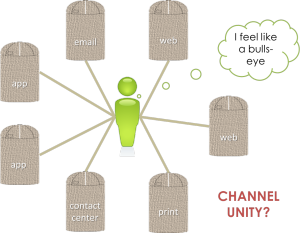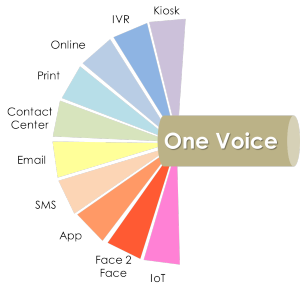August 27, 2015
By Robert Yurkovic
When interacting with consumers, there are many channels for the delivery of communications. Multi-channel and Omni-channel are buzz words many of us use and they enable organizations to deliver communications to consumers through various methods and technologies. The issue I have is it is not a consumer-facing point of view and in some ways companies are abusing the technology that enabled them. With so many channels aimed at a consumer, the consumer feels like a bullseye resulting in an experience that is frustrating and chaotic. This often results in communications that are ignored and discarded, which decreases the opportunity to engage them.

To engage consumers, communications must be cogent … clear, strong and convincing as well as being able to influence the mind and behaviors. The goal should be meaningful communications and not worthless junk mail.
Why does this occur in healthcare and other industries? In healthcare, silo’ed organizations are common place. Each organization wants to reach out to the consumer with their message. Multi-channel platforms and applications provide access to the consumer and if each organization sends their unique communications, the consumer is bombarded with confusing, conflicting, and irrelevant content. No consumer wants pieces of an encyclopedia thrown at them requiring them to fish out relevant information. Consumers have short attention spans and scan material for relevancy in 2-3 seconds.
Coordinated
Organizations are not coordinating their communications across the business so a communication over mobile may be different than a communication over email or a web site. The outcome is a confused consumer, which may result in a phone call to the contact center or discarding the messages altogether as unimportant. If a consumer receives 2, 3, or 4 different communications from various company representatives, they will likely be discarded as the consumer’s perception is all communications are incorrect. Consumers will not spend time validating which communication is correct … this is a formula for a bad game show. The opportunity for engagement suffers and the customer experience deteriorates.
Consistent
Organizations tend to delivery different communications to one consumer even on the same channel. For example, I reached out to a healthcare payer’s contact center for a fairly simple question and received 3 different answers as I stumbled through their IVR system and multiple organizational representatives. 40 minutes of my time was wasted and my goal was not achieved so I was frustrated. The damage doesn’t end there since I communicated my experience with neighbors and friends. Now I am influencing a community and the company’s brand suffers. The lack of consistency of communications results in hours of wasted time and causes a degraded customer experience. The company disengaged me.
Clear
A communication is no good if you cannot understand it. Useful communications that have impact are simple and clear and refine the message to its essential core. No long, endless diatribe and no spouting paragraphs of information. Your audience must be able to understand the message quickly and without confusion.
Relevant
It is a B2C world and everyone wants to touch a consumer within a company and across different companies resulting in an increase of information sent through every possible channel. But is “more” better than “less”? Or is it a question of the right information to the right consumer? Relevant communications has the best chance of capturing a consumer’s attention and engaging them. For example, I receive newsletters from my primary physician’s office, the local regional medical center, urgent care, and several other health-related sources. The print matter ends up in the trash and the emails end up in junk mail. Why? The content does not pertain to me. Why do I want to hear about asthma or diabetes in a generic newsletter since I and my family do not have or are at risk for those conditions? There may be something relevant on page 4, however I did not get that far since I dismissed the communication at page one. The result is the communications deemed useless and failed to engage me. I also associate that company with other companies that send me junk mail, which damages their brand image. I am now conditioned to discard future communications swiftly and they have a very little chance of engaging me in the future.
Why Channel Unity?
Channel Unity means all channels communicate to the consumer with one cogent voice. To the consumer, it doesn’t matter what channel they use, they want to experience useful communications from the company. Companies need to shift their thinking to a B2C Model and embrace Consistent, Coordinated, Clear, and Relevant (CCCR) interactions and communications. Consumers don’t care about all the channels that reach them. They care about a connection to the company and expect it to act with a cogent voice.

I have never seen a company transform and eliminate their deeply embedded silo’s quickly so the solution to Channel Unity must enable data, content, and processes to overlay a company’s business in a way that offers consistent, coordinated, and relevant communications to consumers. Autonomy is protected in the silo’s and a company does not need to wait 5 years for a major cultural shift to occur.
In my recent book, Commercializing Consumer Engagement, I describe best practices and approaches to achieve Channel Unity and consumer engagement without disrupting what is currently working within company. Engagement is all about consumer behaviors and connecting with them in a way that supports their lifestyle.